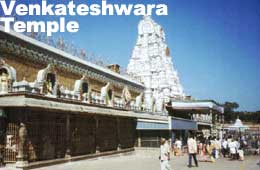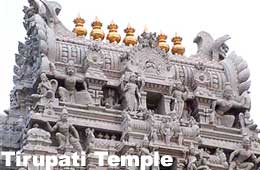| India Profile » Monuments and Temples in India » Venkateshwara Temple | |
Venkateshwara Temple | |
 | |
 The ancient sacred temple of Sri Venkateswara is located on the seventh peak, Venkatachala or Venkata Hill or the Tirupati Hill and lies on the southern banks of Sri Swami Pushkarini. He is also called the Lord of the Seven Hills. The temple of Sri Venkateswara has gained unique sanctity in Indian religious lore. The Shastras, Puranas, Sthala Mahatyams and Alwar hymns have declared that, in the Kali Yuga, one can attain mukti, only by worshipping Sri Venkateswara. The epics like the Rig Veda and the Asthadasa Puranas have described Sri Venkateswara as the great bestower of boons. The temple is said to be the richest temple in the world. There are several legends related with the manifestation of the Lord at Tirumala. The temple has its origins in the ancient sect of Vaishnavism that advocates the principles of equality and love and prohibits animal sacrifice. The sanctum sanctorum or the garbhagriha houses the awe-inspiring idol of the Lord of the Seven Hills, is situated in the main temple complex of Tirumala. It attracts pilgrims from all over the country who stand in line for hours together to obtain a glimpse of the presiding deity for a few fleeting seconds. All the great dynasties of the southern peninsula paid homage to Lord Sri Venkateswara. The Pallavas of Kanchipuram in the 9th century AD, the Cholas of Thanjavur in the 10th century AD, the Pandyas of Madurai, and the kings and chieftains of Vijaya Nagar in the 14th -15th century AD were devotees of the Lord and they vied with one another in investing the temple with ample oblations and donations. During the reign of the Vijaya Nagar dynasty, the contributions to the temple increased. Sri Krishnadevaraya had statues of himself and his consorts installed at the portals of the temple. The statue of Venkatapati Raya can be seen in the main temple. After the decline of the Vijaya Nagar dynasty, the nobles and the chieftains from all parts of the country continued to pay their homage and tender gifts to the temple. The Maratha general, Raghoji Bhonsle, visited the temple and made arrangements for permanent endowment for the conduct of worship in the temple. He also bestowed precious jewels to the Lord, including a large emerald, which is still preserved in a box named after him. Among The later rulers of Mysore and Gadwal have also endowed large amounts to the temple. After the fall of the Hindu kingdoms, the Muslim rulers of Karnataka and later the British took over the temple. Many of the temples came under their supervisory and protective control. In 1843 AD, the East India Company divested itself of the direct management of non-Christian places of worship and native religious institutions.
Several Puranas have mentioned about Sri Venkatachala Mahatmyas out of which the most important are the Varaha Purana and the Bhavishyottara Purana. According to the Varaha Purana, Adi Varaha manifested Himself on the western bank of the Swami Pushkarini, while Vishnu in the form of Venkateswara came to reside on the southern bank of the Swami Pushkarini. Rangadasa was a staunch devotee of Vishnu. One day, in the course of his pilgrimage, he joined Vaikhanasa Gopinatha who was going to the Tirumala Hill for his daily worship of Lord Venkateswara. After bathing in the Swami Pushkarini, he took notice of the lotus-eyed and blue-bodied Vishnu under a tamarind tree. Vishnu was being exposed to the sun, wind and rain. The only protection was by the extended wings of Garuda. Rangadasa raised a coarse wall of stones around the deity and started supplying flowers faithfully to Gopinatha everyday for Vishnu's worship. One day, Rangadasa was distracted by a Gandharva king and his ladies making him forget to supply flowers to Gopinatha. The Lord then revealed Himself and told Rangadasa that He had been examining his continence. Rangadasa had not been steady and had yielded to the temptation. However, the Lord apprehended Rangadasa's devoted service to Him till then. He blessed Rangadasa that he would be reborn as a powerful king of a province and would enjoy the earthly pleasures. He would continue to serve the Lord, construct a beautiful temple with a vimana and high surrounding walls. Rangadasa was reborn as Tondaman, the son of the royal couple, Suvira and Nandini. Tondaman lived a luxurious life as a young man. One day, on a hunting expedition on the Tirumala Hill, he saw Vishnu beneath the tamarind tree. Tondaman inherited his father's kingdom, Tondamandalam. He constructed a prakaram and dvara gopura, and arranged for regular worship of the Lord. In the Kali Yuga, Akasaraja ruled over Tondamandalam and married his daughter Padmavathi to Venkateswara. The marriage was officiated by Brahma and was celebrated with great pomp and grandeur.
The idol of Lord Venkateshwara is imperial, attractive and marvelously executed. The full figure of Lord Venkateswara has the attributes of both Vishnu and Shiva, i.e., the aspects of a preserver as well as the destroyer of the Hindu Trinity. This attribute appeals to both the sects, i.e., Vaishnavites and Saivites. The idol is shown with four arms, first one holding a conch, the second a discus, the third in the abhaya posture while the fourth is resting on the hip. The girdle made of the serpent, an emblem of Lord Shiva, encircles both the front arms. The idol looks graceful when the Lord is draped in all the fineries and ornamentations to give darshan or on the abhishekha day when all the clothes are removed. Everyday is celebrated with great festivity at Tirumala. The most famous festival of the temple is the annual festival called 'Brahmotsavam'. It is celebrated on expansive scale for nine days in the month of September and attracts pilgrims and tourists from all parts of the country. The fifth and ninth days of the festival are especially significant Garudostavam and Rathotavam takes place on these days. |
|
 |
 Sri Seva Dossji of the Hatiramji Mutt at Tirumala was entrusted with the administration of the shrine of Sri Venkateswara and a number of estates. The temple remained under the administration of the Mahants for nearly a century. In 1933 AD, the Madras Legislature passed a special act empowering the Tirumala Tirupati Devasthanams (TTD) Committee to control and administer a fixed group of temples in the Tirumala-Tirupati area, through a Commissioner appointed by the Government of Madras. In 1951 AD, the Act of 1933 was replaced by an enactment whereby the administration of TTD was entrusted to a Board of Trustees, and the Government appointed an Executive Officer. Charitable and Religious Endowments Act, 1966, retained the provisions of the Act of 1951.
Sri Seva Dossji of the Hatiramji Mutt at Tirumala was entrusted with the administration of the shrine of Sri Venkateswara and a number of estates. The temple remained under the administration of the Mahants for nearly a century. In 1933 AD, the Madras Legislature passed a special act empowering the Tirumala Tirupati Devasthanams (TTD) Committee to control and administer a fixed group of temples in the Tirumala-Tirupati area, through a Commissioner appointed by the Government of Madras. In 1951 AD, the Act of 1933 was replaced by an enactment whereby the administration of TTD was entrusted to a Board of Trustees, and the Government appointed an Executive Officer. Charitable and Religious Endowments Act, 1966, retained the provisions of the Act of 1951. The Tirupati temple with its 'gopuram' or tower is one of the finest examples of Dravidian style of temple architecture. The detailed rituals and manner of worship in the temple were prescribed by the saint Ramanujacharya and are being followed till today. The 'Vimana' or Cupola over the sanctum sanctorum or the garbhagriha is covered completely with gold plate and is known as "the Ananda Nilayam". The Shrine comprises of three 'Prakarams' or enclosures. The outermost enclosure contains the 'Dhvajastambha' or the banner post, the statues of Vijaya Nagara king Krishnadevaraya and his consorts and of Todarmal, the minister of Akbar.
The Tirupati temple with its 'gopuram' or tower is one of the finest examples of Dravidian style of temple architecture. The detailed rituals and manner of worship in the temple were prescribed by the saint Ramanujacharya and are being followed till today. The 'Vimana' or Cupola over the sanctum sanctorum or the garbhagriha is covered completely with gold plate and is known as "the Ananda Nilayam". The Shrine comprises of three 'Prakarams' or enclosures. The outermost enclosure contains the 'Dhvajastambha' or the banner post, the statues of Vijaya Nagara king Krishnadevaraya and his consorts and of Todarmal, the minister of Akbar.